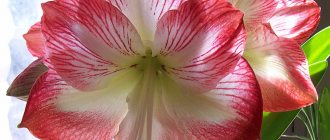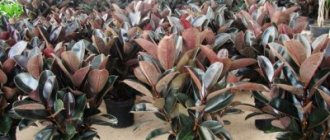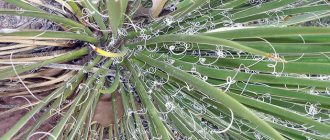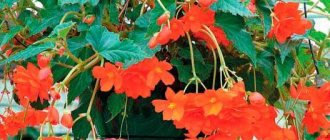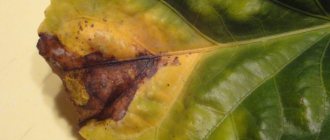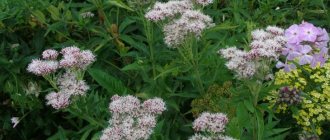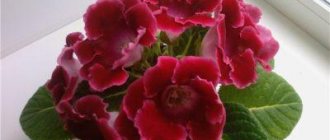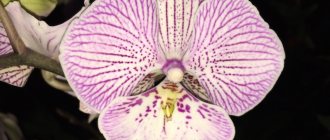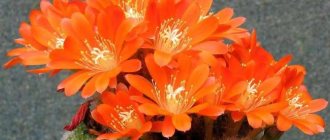- October 30, 2018
- Flowers
- ROME.
There are a huge number of different varieties and hybrids in the begonia genus. West Africa is considered to be the birthplace of the plant. From there, begonias spread to America, Asia, and Indochina. Accordingly, subtropical and tropical climates are considered native to this plant species. The flower received its name in honor of Governor M. Begon, who organized an expedition to collect plants in the Antilles. It was since then that people learned about begonia. All six plant species found during this expedition were named after Michel Begon.
Obtaining new varieties
The plant came to Russia during the time of Peter I. It was brought from Holland along with other types of tropical plants. New varieties of begonia plants began to be intensively developed only in the middle of the 19th century, after new species were found - large-flowered and tuberous begonia.
Many new varieties have been bred in Belgium from the tuberous variety. They are full of colors and have different flower shapes. Tuberous species can be planted in the garden, while others can only be grown indoors.
The leaves of all types of flowers are asymmetrical and have jagged edges. Their colors are varied: there are varieties with monochromatic leaves, and there are those that have up to four or more shades. Flowers can be one-color or two-color. They are painted in a variety of shades. The sepals are bright, uneven, and after flowering the capsule ripens.
Those who grow plants know almost everything about begonia and how to reproduce it. New specimens can be obtained by seeds, leaf fragments, cuttings, shoots, tuber division, and rooting of adventitious buds.
What does it look like?
Root system
The roots have strong branching.
Sometimes they can form tubers. Roots are an important part of the plant, so you need to monitor their condition. To keep them healthy and perform their functions well, you need to monitor the soil temperature.
If it is below 17°C, then the absorption function of the roots decreases, which can lead to their rotting. Root rot can be caused by overwatering.
In summer and spring, you need to water as often as possible. The main thing is to ensure that there is no stagnation of water. The plant should be watered when the top layer of soil dries 1-2 cm. Water for irrigation should be at room temperature.
For the health of the roots, it is useful to add a little top layer of soil every six months to provide the roots with air flow.
Tuber
The tuber is an important part of the begonia. It is from the tubers of the plant that its cultivation most often begins.
A healthy tuber has the following characteristics:
- the diameter should be within 2-4 cm;
- the top of the tuber should be firm and smooth.
Tubers have a lower and an upper side. On the upper side there are buds that look like small mounds and bumps. The underside is smooth. It is on this that roots subsequently form.
Stem
The stem can be either erect or elastic, stretching to the ground. It may have branches and pronounced nodes.
The height of the stem can vary from 15 to 60 cm depending on the type of plant.
In nature, there are begonias without stems, having only one leaf.
The number of internodes on the stem can vary from 10 to 12 depending on the number of leaves.
Young plants have thin and fragile stems, so they must be handled with care. As the plant matures, its stem becomes woody.
Flowers
The inflorescences have the appearance of a complex panicle with branches growing on the sides.
In the axil of each leaf of the shoot, a new inflorescence develops, containing from 3 to 5 inconspicuous female and brightly colored male flowers.
The female flower includes 4-5 petals, a calyx of 3 sepals and 2 bracts. Male - 4 elongated petals, 2 round membranous bracts and 2 sepals.
Depending on the type of plant, it can have smooth-petaled or double flowers of a wide variety of colors and sizes. They have brightly colored perianth.
For example, tuberous begonia has a flower measuring 7-15 cm, and evergreen begonia has a large number of small flowers ranging in size from 2 to 3 cm.
The fruit is a winged three-lobed capsule with cracks on the sides. It contains small bright yellow seeds in which the embryo develops to continue the plant species.
Leaves
The leaves are large and fleshy. They are located asymmetrically on the cuttings. The leaf plate of the plant is smooth and wide, has a simple shape. There are veins on it.
Different types of begonias have different colors and leaf sizes:
- Coral begonia: the upper part of the leaf is silver with yellow-green veins, the lower part is purple.
- Rex: The leaves have a broad oval shape and serrated edges, and the color can be silver or range from pink to purple.
- Red-leaved begonia: the leaf blade is smooth and hairless, has a rounded shape, the lower part of the blade is colored red.
Varieties of flowers
The diversity of domestic begonias is so great that connoisseurs of these plants still cannot come to a unified system for classifying species, but have developed many different criteria. Thus, all plants are divided according to the type of stem, decorative foliage, flowers, growing method, and type of root system.
Knowing everything about begonia, you can get an idea of how to care for the plant. Based on this, it is worth understanding the principles of classification. Most often, color division occurs according to the following principles:
- Application and decorative effect. According to this principle, plants are divided into decorative-flowering and decorative-deciduous.
- Root system. There are tuberous plants with rhizomes and a superficial root system.
- Type of growth, shoots. There are bushy, drooping and lodging begonias.
Recommendations
- "Begonia - Welcome."
- David G. Frodin (2004). "History and ideas about the genera of large plants." Taxon
.
53
(3):753–776. Doi:10.2307/4135449. JSTOR 4135449. - Moonlight PW, Ardi WH, Padilla LA, Chung KF, Fuller D, Girmansyah D, Hollands R, Jara-Muñoz A, Kiew R, Leong WC, Liu Y, Mahardika A, Marasinghe LDK, O'Connor M, Peng CI, Pérez ÁJ, Phutthai T, Pullan M, Rajbhandary S, Reynel C, Rubite RR, Sang J, Scherberich D, Shui YM, Tebbitt MC, Thomas DC, Wilson HP, Zaini NH, Hughes M. (2018). "Division and subjugation of the fastest-growing genus: towards a natural sectional classification of the mega-diverse genus Begonia
(Begoniaceae)."
Taxon
.
67
(2):267–323. Doi:10.12705/672.3.CS1 maint: uses the authors parameter (link) - List of plants
- Perry, Leonard. "Begonia".
- "AGM Plants -Ornamental" (PDF). RHS. March 2022. p. 10. Retrieved November 1, 2022.
- " Begonia
'Benitociba'". RHS. Retrieved October 29, 2022. - " Begonia dregei
". RHS. Retrieved October 29, 2022. - « Leaf begonia
var.
miniata
." RHS. Retrieved October 29, 2022. - " Begonia
'Glowing Embers'". RHS. Retrieved October 29, 2022. - « Begonia large
subsp.
Evansiana
". RHS. Retrieved October 29, 2022. - « Begonia large
subsp.
Evansiana
var.
Alba
". RHS. Retrieved October 29, 2022. - " Begonia
'Green Gold'". RHS. Retrieved October 29, 2022. - " Begonia listada
". RHS. Retrieved October 29, 2022. - " Begonia luxurians
." RHS. Retrieved October 29, 2022. - " Begonia masonica
". RHS. Retrieved October 29, 2022. - " Begonia metallica
". RHS. Retrieved October 29, 2022. - " Begonia solananthera
." RHS. Retrieved October 29, 2022. - " Begonia solid-mutata
". RHS. Retrieved October 29, 2022. - " Begonia sutherlandii
". RHS. Retrieved October 29, 2022. - Laferriere, Joseph E. 1990. On the edibility of begonias. Begonian 57:175.
Classifications by V.V. Vorontsov, European
In his work, Professor V.V. Vorontsev told everything about begonia and gave a classification of plants, which is most often used by gardeners. So, in his opinion, all varieties should be divided into:
- tuberous;
- decorative deciduous;
- decorative flowering;
- shrubby.
There is a European system for dividing species. According to it, plants are classified into scrubs, ever-flowering, tuberous, ampelous, caudex, rhizomatous, royal, and cane.
Homeland of begonia
In the wild, the plant is distributed in the subtropics and tropics of America, Asia, and Africa. Many types of flowers grow in forests that are characterized by high humidity. However, begonia can also grow on rocks, mountains, and even on other plants.
No one knows where begonia was first noticed. But there are legends associated with the opening of the flower. So, in the 17th century, the French monk C. Plushier first saw begonia. The plant was spotted on the island of Haiti during an expedition. He was the first to describe the plant, which he called begonia. The name of the flower is in honor of the governor of the island, Michel Begon, who collected rare plants.
According to another legend, in 1689, the same Michel Begon organized a scientific expedition to the West Indies. There a flower was discovered, which was named in honor of the patron philanthropist. Since then, in subsequent years, several hundred different forms of the plant have been discovered and described.
Plant groups
When growing begonias at home, the classification according to the presence of a stem and its type is taken into account:
- Decorative deciduous. These species do not have a stem; the foliage grows directly from the root. These plants decorate window sills and loggias. The most popular varieties are royal, mason, metallic, cuff, hogweed, tiger, and red-leaved bagonia.
- Bush species. This includes all indoor begonias, which are said to look like bamboo. These species include red, coral, fuchsia, and evergreen.
- Tuberous. Typically, begonias belonging to this species are planted in open ground in the summer, used in hanging pots, and used for landscaping balconies.
Care and maintenance
Begonia is easy to care for, because it is unpretentious and resistant to various diseases. To get a beautiful plant with lush leaves, it is necessary to provide high air humidity. To do this, place the pot with the plant on a tray with damp peat or sand, but so that the water does not touch the bottom. Pebbles can be used, and the pot is raised, placed on an inverted saucer.
It is recommended to spray the air around the begonia. It is important to ensure that drops of water do not fall on the foliage or flowers.
For normal growth and development, the plant must be provided with a temperature of approximately +20 in summer, and not lower than +15 degrees in winter. Begonia prefers bright, diffused light, but in direct sunlight the foliage burns. In winter, it is recommended to place the flower pot in the sun in the mornings and evenings. Ever-flowering varieties tolerate sunlight and partial shade well, but in the shade they lose their decorative brightness and stretch out.
During the growing season, fertilizing should be carried out. This must be done at least twice using a complete complex mineral fertilizer intended for flowering or ornamental deciduous plants.
Useful properties of the flower
Whether or not to believe in such capabilities of the green handsome man is a personal matter for everyone, but, in addition to magical abilities, he also has healing properties :
- the ability to quickly heal wounds;
- is an excellent antiseptic;
- has antiallergenic and antispasmodic effects;
- good pain reliever.
In addition, it perfectly cleans the air of dust and neutralizes harmful radiation . It has a beneficial effect on people susceptible to colds and respiratory diseases.
Tip: place a pot with these flowers near your computer; it will get rid of harmful radiation just as well as a cactus. In addition, begonia leaves absorb dust, purifying the air.
Begonia flowers, which have a whole range of shades, have a color therapeutic effect .
Orange tones help relieve depression and improve your mood. Yellow ones can relieve fatigue from the eyes, red ones activate life processes.
Begonia flowers have medicinal properties, leaves absorb dust, purifying the air
Transfer
Begonias are replanted every two years, in the spring. The new pot is selected in such a way that its diameter is 2-3 cm larger than the previous one.
First, the plant is removed from the pot. Excess soil is removed from the root system. The roots are then placed in a solution of potassium permanganate to treat them.
While the plant is disinfected, a new pot is prepared. A layer of expanded clay, a layer of sand, and a little soil are poured onto its bottom. Then the plant is placed in the pot, all voids are filled with soil. After transplantation, the seedling is watered abundantly. You should not place the transplanted plant in a sunny place. First, it is given a couple of weeks to take root, and only after that it is moved to a permanent place.
Reproduction methods
Tuberous begonias reproduce by seeds and tubers; other species reproduce well by leaf and stem cuttings.
Tuberous propagation is carried out in the fall. The bulbs are removed from the ground, cleaned and stored until forcing, creating conditions under which they will not dry out (the storage temperature should not be higher than +10 degrees).
In February, the tubers are taken out and planted in pots. They should be small, and the bulbs themselves should be deepened by half.
Tuberous begonia should be watered sparingly, with caution, avoiding water getting on the tubers. Under optimal conditions, sprouts will appear in 2-4 weeks. At this moment, soil is poured into the pot.
Phylogeny
The following phylogenetic tree shows the relationships between sections of the genus Begonia
.[3]
| Begonia | |
| Section Loasibegonia | |
| Nerviplacentaria – | |
(MB)
| Section Squamibegonia | |
pro parte
| Section Rostrobegonia | |
| Section Latistigma | |
| Begonia acetosa Clade | |
| Wagneria Clade | |
Clade
| Haagea section | |
| Section Reichenheimia pro parte | |
| Section Diploclinium pro parte | |
| Section Platycentrum | |
| Section Bracteibegonia | |
–
Symbegonia
Clade
| Neotropical Clade 2 | |
| Chapter Knezebecka Me + | |
| Gobenium section | |
| Section Uniform | |
| Solananther Section | |
| Section Trachelocarpus | |
| Pilderia section | |
| Caspar – | |
| Section Cyathcnemis | |
Variety
Main article: List of begonia species
Selected species:[4]
- Begonia coccinea
- Begonia leaf
- Begonia large
Dryand. - Begonia oblique
- Corn begonia
Other propagation methods
The most difficult thing to propagate begonia is from seeds. Sowing lasts from December to March. The seeds are sown in a specially formulated substrate. For it, peat, sand, earthen and leaf soil are taken in equal parts. Begonia seeds are small, which is why they are not buried, but scattered over the surface of the soil. After 2-3 weeks, the first shoots appear. During growth, up to three picks are carried out.
Grown specimens of the plant are planted in separate containers along with a lump of earth. Flowers bloom in July-August, and tubers grow in winter.
Leaf varieties of begonias are most easily propagated by leaf cuttings, dividing the bush during replanting. For propagation, the first method is to prepare a cutting at least five centimeters long. The cuttings are planted immediately in the ground, covered with a bag and left until roots form.
Growing problems:
Begonia Raspberry Swirl.
- Begonia does not bloom for a number of reasons: lack of lighting, too dry indoor air, excess fertilizer, drafts, too low room temperature or, conversely, too high.
- Leaves dry out most often due to too dry indoor air and insufficient watering.
- Leaves droop and turn yellow in a room with too low a temperature combined with waterlogged soil.
- Yellow spots and rings on the foliage indicate that the plant is infected with tomato blight or cucumber mosaic. Such plants must be destroyed immediately.
- Yellowing foliage indicates a lack of moisture
- Curling of the foliage occurs when there is an excess of watering, very hot conditions, or a lack of minerals in the soil, if the plant has been sprayed.
- Begonia buds fall off due to lack of lighting, fertilizers, dry air and improper watering.
- Foliage falls when there is insufficient lighting.
- Begonia is very elongated, thin stems, little foliage due to lack of lighting.
Views: 1,134
